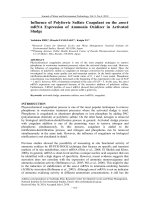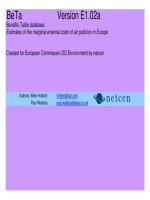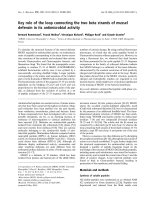studying the optimum incubated conditions of anaerobic bacteria in rice husk
Bạn đang xem bản rút gọn của tài liệu. Xem và tải ngay bản đầy đủ của tài liệu tại đây (296 KB, 25 trang )
MINISTRY OF EDUCATION & TRAINING
CAN THO UNIVERSITY
BIOTECHNOLOG Y R & D INSTITUTE
SUMMARY OF BACHELOR THESIS
THE ADVANCE BIOTECHNOLOG Y PROGRAM
STUDYING THE OPTIMUM INCUBATED
CONDITIONS OF ANAEROBIC BACTERIA IN
RICE HUSK
SUPERVISOR
VO VAN SONG TOAN
DUONG THI HUONG GIANG
STUDENT
VAN HUU LOC
Student code: 1065586
Session: 32 (2006-2010)
Can Tho, 2010
APPROVAL
SUPERVISOR
STUDENT
VO VAN SONG TOAN
VAN HUU LOC
DUONG THI HUONG GIANG
Can Tho, December 3, 2010
PRESIDENT OF EXAMINATION COMMITTEE
Ass.Prof. Cao Ngoc Diep
ABSTRACT
Twelve anaerobic isolates were screened for cellulolytic
capacity on rice husk. The soil isolate, annotated as 84, gave the
highest cellulase activity. The growth rate peaked at 96h of
incubation, with the cell density of 35.11 x10 7 CFU/ml. Species
identification by Microlog system 4.20.04 (Biolog, 2004), with the kit
GN2 revealed that the isolate is belong to the Acinetobacter genera.
This bacteria adopted high hydrolytic activity on rice husk at 30 0 C,
pH 7; which was enhanced by induction with 1% lactose. The
cellulase production of the isolate 84 reached peak at the fifth day.
Final protein content, CMCase and avicelase activities were
determined as 0.19 mg (in 15ml of cultural solution), 0.197 U/ml and
0.181 U/ml, respectively. The cellulose hydrolytic yield was 5,46% at
5 days of incubation.
Key word: Acinetobacter, cellulase, lactose, rice husk
i
CONTENTS
Content
1. Introduction
2. Materials and methods
3. Results and discussion
3.1. Determination of cellulose content of rice
husk
3.2. Screening of anaerobic bacteria capable to
degrade rice husk
3.3. Selection of the isolates exposing highest
cellulolytic activities
3.4. Growth curve of the isolate 84
3.5. Identification of the scientific name of the
isolate 84
3.6. pH-temperature optimum for the growth of
isolate 84
3.7. Lactose induction of cellulase production
of the isolate 84
3.8. Study of the optimum cultivation time for
the isolate 84
3.9. The cellulolytic capacity of isolate 84 on
different substrates
4. Conclusions
5. Suggestions
References
ii
ii
1
4
8
8
8
9
10
11
12
13
14
16
19
19
1. INTRODUCTION
Most agricultural wastes of crop plants, particularly cereals,
are rich in lignocellulosic materials, of which cellulose is the main
constituent. Association of cellulose with lignin, another complex
polymeric molecule composed of phenylpropanoid units, form
lignocelluloses. Also hemicellulose is another major celulosic
component. Bacterial enzymatic degradation of these materials is
extremely slow because of the stable structure of the lignocelluloses
complex. Besides, there are only a few species of bacteria and fungi
which are able to breakdown such materials.
Enzymatic degradation of cellulose requires the synergystic
action of a family of cellulolytic enzymes that have been classified
into three major groups: endoglucanases (CMCase, EC 3.2.1.4)
whcih cleaves internal β-1,4-glycosidic bonds, exoglucanase
(Avicelase, EC 3.2.1.91) which releases cellobiose from the nonreducing end of cellulose, and cellobiase (β-1,4-glycosidase, EC
3.2.1.2) which hydrolyses cellobiose to glucose (Wood and Bhat,
1998).
Viet Nam is the second largest rice exporter in the world. The
rice industrial process generates a large amount of fibrous byproducts and wastes, especially rice husk. This material is mainly
composed of 25-30% lignin, 10-15% hemicellulose and 35-40%
cellulose (Elijah T. Iyagba et.al, 2009). In the Mekong Delta, it has
been approximately estimated to 3,600,000 tons per year. Treatment
of these wastes is partially done by using as fuel, while the major
part is discarded to the environment.
To contribute to enviroment solving problem, this research
aimed at selection of the most potential bacteria which are able to
1
degrade rice husk and optimization of culture conditions for highest
cellulolytic activities of the selected bacteria.
2
Objectives:
- To isolate, select and identify anaerobic bacterial isolates having
high cellulolytic activity.
- To study the optimum conditions for the cellulase production.
- To study the degradation ability of the selected isolates on 3
different substrates: rice husk, sugarcane bagasse, and rice straw.
3
2. MATERIALS AND METHODS
2.1. Materials
- Devices:
+ Spectrophotometer (Pharmacia LKB – Ultrospec,
USA)
+ Eppendoft centrifuge (Rotor – Germany).
+ Eppendoft thermal shaker (Eppendorf – Germany).
+ Refrigerator and some laboratory equipments
+ Microlog system 4.20.04 (Biolog, 2004)
- Samples: rice husk from rice mill factory in Can Tho city.
- Materials for culture medium: CMC, K 2 HPO4 , MgSO4 .7H2 O,
Lactose, NaCl, agar, Ammonium sulphate, grinded rice husk…
- Chemicals: Congo red, HCl, Javen solution, Bovin Serum
Albumin (BSA), Tris-HCl (Sigma), Sodium hidroxide (NaOH),
Bromophenol blue, Acetic acid, Nelson reagent, Braford reagent …
2.2. Methods
a) Determination of cellulose content in rice husk
+ Objective: To define the cellulose content in rice husk.
+ Method:
- Collecting rice husk from rice processing factory in
Can Tho city
- Grinding rice husk into powder.
- Define the cellulose content by using NaOH 0.5%,
HCl 10% and javel solution.
- Determining the cellulose content.
b) Screening of anaerobic bacteria capable to degrade rice husk
+ Objective: To obtain the pure isolates of anaerobic bacteria
+ Method:
4
- Culturing 12 isolates on rice husk agar medium, 4-5
times repeated until the pure culture is obtained.
- Morphologically description of bacterial colonies
c) Selection of the isolates exposing highest cellulolytic activities
+ Objective: To select some isolates that expose highest
hydrolytic activities
+ Method:
- 5 µl of bacteria solution was dropped into the wells
made on the Petri disks of rice husk agar medium and incubate
for 5 days.
- Congo Red was used for screening of the hydrolytic
zones surrounding bacteria colonies.
- Measuring the diameters of those zones to estimate the
cellulolytic activities.
d) Studying the growth rate of selected isolates
+ Objective: To determine the density of bacteria by the time
+ Method:
- Bacteria was inoculated into the broth of rice husk
medium.
- Every day, 100µl of culture solution was taken and
diluted into 10, 102 , 103 …108 times, then grow on petri dishes
and the number of bacteria was counted based on the number
of colony formed.
e) Identification of the scientific name of selected isolates
+ Objective: To define the scientific name of selected isolates
+ Method:
- Isolate a pure culture of selected isolates. Due to Gram
staining the testing MicroPlate GN2 was selected.
5
- Put the colony of those isolates into 1 tube to compare
the turbidity with the standard tube.
- Inoculate 150µl above solution to MicroPlate.
- Incubate 300 C. After 24h, read the result by
MicroStation Reader.
f) Studying the effects of pH and temperature on the production
of selected bacteria
+ Objective: To define the optimum pH and temperature for
the cellulase production of the selected bacteria
+ Method:
- 5 µl of bacteria suspension was dropped into the
readymade wells on the rice husk agar medium. The pH of the
medium was in a range of 4, 5, 6, 7, 8, 9, 10, 11. Incubate 5
days at the different temperature of 25, 30, 35, 40, 45, 500 C.
- Using congo red to screen the hydrolytic sphere zones
surrounding bacterial colonies on rice husk agar medium.
- Measuring the diameters of hydrolytic spheres to
estimate the cellulolytic activity.
g) Studying the effect of lactose concentration on the cellulase
production of the selected bacteria
+ Objective: To define optimum lactose concentration for the
cellulase production of those bacteria
+ Method:
- 5 µl of bacteria suspension was dropped into the
readymade wells on the rice husk agar medium with lactose
concentration of 0, 0.25, 0.5, 0.75, 1, 1.25, 1.5, 1.75, 2, 2.25,
2.5%. Incubate for 5 days.
6
- Cellulolytic activities were determined as described in
the above experiment.
h) Studying the optimum time for cellulase production.
+ Objective: To determine the optimum incubation time when
the enzyme productivity is high.
+ Method:
- Inoculate the bacteria into 27 tube of rice husk liquid
medium.
- The cellulolytic activities were tested every day for
protein content by Bradford method and enzyme activity by
Nelson Somogyi method.
- Determination of hydrolysis yield by the remained rice
husk in the culture media.
i) Studying the cellulolytic activities of the selected isolates on
different substrates
+ Objective: To define the hydrolytic ability of bacteria in 3
different substrates such as rice husk, sugarcane bagasse, and
rice straw.
+ Method:
- Inoculate the bacteria in liquid medium of rice husk,
sugarcane bagasse and rice straw.
- Testing the protein content by Bradford method and
enzyme activities by Nelson Somogyi method.
7
3. RESULTS AND DISCUSSION
3.1. Cellulose content of rice husk
The cellulose content of the rice husk explored in the
experiment was 41,06%. This amount is equivalent to the result of
Elijah et.al (34.34 - 43.80%). Lignin contaminant was also present in
the analyzed sample that made the measurement not 100% accurate.
According to Sun et.al (2004), materials harboring 44.7% of
cellulose would contain ca. 5.7% hemicelluloses and 1.6% lignin.
Besides, rice husk also consists of crude protein, carbohydrates, lipid
and inorganic compounds. Cellulose content is also different among
rice species. Hwang and Chandra (1996) showed that Japanese
possessed higher holocellulose (hemicelluloses and cellulose) than
Indian rice.
3.2 Screening of anaerobic bacteria capable to degrade rice husk
Morphological observation has been revealed that, among 12
isolates tested, there were seven of smooth colony form (63, 64, 66,
67, 76, 80, 84), two of curled form (65, 83), two of wavy form (72,
85) and one of lobated form (62). Regarding the elevation, there
were five isolates with umbonated elevation, five isolates with flat
and two isolates with raised elevation.
All 12 isolates are Gram negative. They can be monococci,
diplococci, and streptococci groups, of which 50% were motile.
8
Gram negative
coccus
Gram negative
dip lococcic
Gram negative
streptococci
Figure 1. Gram staining and cell forms of the tested isolates
3.3 Selection of the isolates exposing highest cellulolytic activities
Table 1. Cellulolytic capacity of the investigated isolates
Isolates
Diameter of hydrolytic zone (mm)
62
6.00g
63
10.67de
64
6.00g
65
7.00 f
66
11.33cd
67
10.33e
72
12.00bc
76
11.67bc
80
6.00g
83
6.00g
84
13.33a
85
12.33b
Notes: Values are mean of triplicates. Means with different
subscripts within a column are statistically significant different at
5%.
9
According to the data on table 1, it is obvious that the isolate
84 adopted highest cellulolytic activities with 13.33 mm diameter of
the hydrolysis zone. While the isolate 85 was lower in hydrolysis
activities (12.33mm). Four isolates named 62, 64, 80, and 83 had no
hydrolytic zone, indicating that there is no cellulase production.
Thus, the isolate 84 could be grown on rice husk medium for
cellulase production. According to Trần Thị Ánh Tuyết and Trương
Quốc Huy (2010), the hydrolytic zone diameter of Bacillus subtilis
was 22 mm on CMC-agar medium. The difference might be due to
the fact that CMC has simpler molecule structure than the
lignocelluloses complex so that cellulose breakdown would be
easier. Conclusively, the isolate 84 was chosen for the later
experiments.
3.4. Growth curve of the isolate 84
The lowest density obtained at 0h. The figure (Figure 2) did
not show the lag phase, it might conclude that the chosen period
(24h) was too large to obtain the lag phase. Stable phase was reached
after 96 hours and stayed remained until 144 hours .After 24h, the
log of numbers of bacteria increased and reached the peak at 96h,
followed by the death phase. In the lag phase, the bacteria needed
time to adapt with new medium. In log phase, the bacteria density
increase was geometric progression while the growing time was
arithmetic progression. The actual rate of this growth (i.e. the slope
of the line in the figure) depended upon the growth conditions, which
affected the frequency of cell division events and the survival of
daughter cells.
10
Figure 2. Growth curve of isolate 84
Exponential growth could not continue indefinitely because
the medium was then nutrients-depleted and enriched with wastes.
Consequently, the bacteria entered the stationary phase, in which
growth rate was equal to death rate. The growth rate slows resulted
from nutrient depletion and accumulation of toxic products. Soon
later, the nutrient exhaustion made the bacteria enter the death phase,
in which bacteria density started decreasing. There was no general
rule for this phase. The study in Pythium aphanidermatum (Onuh
and Ohazurike, 2000) also showed that the time to get the maximum
density of this fungus was 96h. Then at the day of 7, the density
reduces 50%. The statistic result indicated the difference between
96h and 120h was not significant. So, 96h was the best time to get
the highest density of bacteria.
3.5. Identification of the scientific name of the isolate 84
11
Initially, the data obtained from MicroStation Reader
showed that isolate 84 was Acinetobacter sp. The bacteria belong to
the phylum Proteobacteria, class Gammaproteobacteria, order
Pseudomonadales, family Moraxellaceae, and genus Acinetobacter.
Non-motile Acinetobacter species are oxidase-negative and occur in
pairs under microscopy. They are important soil organisms because
of the contribution to mineralization of aromatic compounds. Reisolation and identification gave the same results. Ekperigin (2007)
reported that Acinetobacter anitratus gave the highest cellulase
activity of 0.48 U/ml. Hrenović et.al (2005) showed that the
Acinetobacter calcoaceticus had ability to accumulate phosphor,
which helped improve the waste water treatment process.
Acinetobacter isolates are capable to degrade a wide range of
aromatic compounds.
3.6 pH-temperature optimum for the growth of isolate 84
Figure 3 showed that the pH-temperature optimum for the
growth of isolate 84 was 300 C, pH 7. The corresponding hydrolytic
zone diameter was 15mm. Isolates with diameters of 6 mm, which
was the diameter of the wells, had no cellulolytic activity. This
isolate 84 did not produced cellulases at strong acidic (≤ 4) and
alkaline pH (≥ 11), thus the isolates have cellulase production
capability at a wide pH range. High temperatures resulted in activity
loss of cellulase, but a minor hydrolysis activity at 500 C had been at
slightly acidic pH (5 and 6). Thus, the isolate 84 might belong to
temperate thermopilic bacteria. Chakraborty et.al (2000) claimed that
the pH optimum of Cellulomonas sp was pH 7 in the temperature
range of 30-370 C. Similar results were obtained from the study of
Trần Thị Ánh Tuyết and Trương Quốc Huy (2010), in which the
12
optimum conditions for Bacillus subtilis growth were pH 7 and 300 C.
Figure 3. Hydrolytic diameters, presenting relative
cellulase activity of isolate 84 at different pH and temperatures
3.7 Lactose induction of cellulase production of the isolate 84
The cellulolytic activity could be significantly improved when
1% or 1.25% (v/w) lactose was added to the medium, as seen in the
corresponding hydrolytic diameter of 20.4 mm in comparison to the
control (15.67 mm) and previous experiment (15 mm). Hence, the
relative cellulase activity could be increased 1.3 times. Higher
lactose concentration (1.75% and 2.5% (w/v)), in contrast, resulted in
activity loss when the halo diameters were decreased to 14,7mm and
12,53 mm, respectively. It means that lactose was probably an
inducer of the cellulase biosynthesis of the bacteria at appropriate
concentration. Morikawa et.al (1995) indicated that lactose made the
cellulase activity increased 2-3 times. Study of Alazzeh et.al (2009)
13
also proved that β-galactosidase activity of Lactobacillus reuteri
could increase by lactose induction.
According to Mandels and Reese (1956) lactose was a much
better inducer for cellulase activity than the others. On lactosecontaining medium, cellulose hydrolysis yield increased as sugar
concentration rises to 0.75 per cent and then leveled off.
Hydrolytic diameter (mm)
Lactose concentration (%)
Figure 4. The induction effect of lactose on cellulase
production of the isolate 84
3.8 Study of the optimum cultivation time for the isolate 84
Highest total protein content of 0.19 mg was achieved after 5
days (Figure 5), which corresponded to the stationary phase of the
bacteria (Figure 2). This density was high, but in 5th day, this density
was not change. Later reduction in protein content resulted from
denaturation, proteolysis and cell death. Protein content, especially
cellulase content, is remarkably high in cellulase-producing fungi
like Trichoderma. According to Kazuhisa (1997) the cellulase
14
content of T. reesei KDG-3 mutant in semi-batch culture was 36.7
mg/ml.
Total
protein
content
(mg)
Time (day)
Figure 5. Total protein content over time
The endo- and exocellulase enzymatic activities of the isolate
84 was simultaneously determined for CMCase and avicelase using
CMC and Avicel, respectively, as substrates. Maximal activity was
fit with the protein content, which peaked at day 5 of fermentation
process (Figure 6).
It was observed that endoglucanse (CMCase) activity was
always slightly higher than exoglucanase activity (avicelase). The
molecular structure of CMC was simple and specific for
endoglucanase, so the endoglucanase activity may more dominant
than exoglucanase. Highest activities of these two were determined
as 0.197 U/ml and 0.181 U/ml, respectively after 5 days. Ram et.al
(1991) reported that Clostridium thermocellum isolate SS8 secreted
both CMCase and avicelase when cultured in cellulose-containing
medium, and about 85% cellulase was extracellular enzyme.
15
Avicelase activity was increased in the presence of DTT and Ca2+.
Conclusively, the final hydrolytic productivity of the process was
5.46% after 8 days.
Activity(U/ml)
Ti me (day)
Figure 6. CMCase and avicelase activities of isolate 84 over
time
3.9 The cellulolytic capacity of isolate 84 on different substrates
In this study, isolate 84 efficiently hydrolyzed the rice husk.
The bacteria were also viable on the media containing other
substrates like sugarcane bagasse and rice straw, but did not generate
the hydrolytic zone. The bacteria was isolated from soil and
continuously cultured on rice husk-containing medium, by which
they possibly gained the specificity to this substrate.
16
Protein content determined in liquid medium agreed with
that on agar medium, and was significantly more than those from
other media (Figure 7).
Total
protein
content
(mg)
substrates
Rice husk
Sugarcane bagasse
Rice straw
Figure 7. Protein content of Acinetobacter on 3substrates
CMCase and avicelase activities on rice husk were 0.093 U/ml
and 0.88 U/ml, respectively, which were 4 times more than those on
sugarcane bagasse, and 2 times more than on rice straw (Figure 8).
17
Activity
(U/ml)
Rice husk
Sugarcane
bagasse
Rice straw
Substrate
Figure 8. CMCase and avicelase activities of
Acinetobacter isolate 84 on different substrates
The result once again suggested the higher specificity of
Acinetobacter to rice husk in comparison to other substrates, thus
rice husk was more beneficial for this bacteria to produce cellulase
with high activity. Acinetobacter junii and Acinetobacter lvoffii also
have high ability to degrade the lignocellulosic waste (Bujak and
Targoński, 1998).
18
4. CONCLUSION
- The cellulose content in rice husk was 41%.
- 8 out of 12 isolates exhibited cellulolytic ability on rice
husk-agar medium. Among them, the isolate 84 possessed highest
cellulolytic activities.
- The isolate 84 was Gram negative, diplococus and non
motile bacteria. It belongs to Acinetobacter genus, and had a typical
growth curve in which stationary phase was reached after 4 days.
- The optimal conditions for the cellulase produced of the
isolate 84 were pH 7 and 300 C. Induction with 1% lactose resulted in
1.3-fold increasing in the cellulose hydrolytic capacity. Total protein
content, CMCase and avicelase activities were determined as 0.19
mg, 0.197 U/ml and 0,181 U/ml, respectively. The final
cellulohydrolytic yield was 5,46% after 8 days.
- The isolate 84 hydrolyzed rice husk more efficient than
other substrates on agar medium. Broth culture resulted in protein
content of 0.15 mg protein after 4 days. The CMCase-avicelase on 3
substrates rice husk, sugarcane bagasse and rice straw were: 0.093 0.088 U/ml; 0.023 - 0.022 U/ml; 0.050 - 0.045 U/ml, respectively.
5. SUGGESTION
- Fully characterizations of the selected isolate 84 by
scientific name.
- Improvement of the cellulase production of this isolate on
different carbon and nitrogen sources, and study the effect of some
minerals on the cellulase biosynthesis.
- Studying the up scaling of the broth culture for cellulose
hydrolytic
capacity.
19
REFERENCES
Alazzeh, A. Y., S. A. Ibrahim, D. Song, A. Shahbazi and A.A.
AbuGhazaleh. 2009. Carbohydrate and protein sources influence
the induction of α- and β- galactosidases in Lactobacillus reuteri.
Food Chemistry 117( 4): 654-659
Bujak, S. and Z. Targoński. 1988, Mikrobiologiczna degradacja
materiałów celulozowych, Postępy Mikrobiologii, XXVII, z. 3,
211-241
Chakraborty, N., G. M. Sarkar and S. C. Lahiri. 2000. Cellulose
degrading capabilities of cellulolytic bacteria isolated from the
intestinal fluids of the silver cricket. The Environmentalist, 20: 911
Ekperigin, M. M. 2007. Preliminary studies of cellulase production
by Acinetobacter anitratus and Branhamella sp. African Journal
of Biotechnology 6 (1): 028-033
Elijah, T. I., I. A. Mangibo and Y. S. Mohammad. 2009. The study
of cow dung as co-substrate with rice husk in biogas production.
Scientific Research and Essay Vol.4 (9), pp. 861-866.
Hrenović, J, D Tibljaš, Y Orhan and H Büyükgüngör. 2005.
Immobilisation of Acinetobacter calcoaceticus using natural
carriers. ISSN 0378-4738 = Water SA 31(2), 261-266.
Hwang C. L., and S. Chandra. 1997. Waste materials used in
concrete manufacturing. William Andrew Inc., USA, pp 184–
234.
Kazuhisa, M. 1997. Renewable biological systems for alternative
sustainable
energy
production.
M-09
ISBN 92-5-104059-1.
Mandels, M. and E. T. Reese. 1956. Induction of cellulase in
Trichoderma viride as influenced by carbon sources and metals.
Biology Branch, Pioneering Research Division, Ur. S. Army
Quartermaster Research and Development Center Natick,
Massachusetts
Morikawa, Y., T. Ohashi, O. Mantani and H. Okada. 1995. Cellulase
induction by lactose in Trichoderma reesei PC-3-7. Appl
Microbiol Biotechnol 44:106 111
Onuh and Ohazurike. 2008. Effects of culture ages on the production
and activities of polygalacturonase and cellulase (Cx) enzymes
produced by Pythium aphanidermatum (edson fitzpat.) isolated
from soft stem rot disease of cowpea. Science World Journal, 3
(2): 5-9
Ram , S. M., C.V. Rao and G. Seenayya. 1991. Characteristics of
Clostridium thermocellum strain SS8: a broad saccharolytic
thermophile. World Journal of Microbiology and Biotechnology
7, 272-275.
Sun, J.X. 2004. Isolation and characterization of cellulose from
sugarcane bagasse. Polymer Degradation and Stability 84, 331339
Trần Thị Ánh Tuyết and Trương Quốc Huy. 2010. Investigation of
culture conditions and methods of cellulase enzyme extracted
from Bacillus subtilis. Seltected conference report research
students 7 th Da Nang university
Wood, P. J. 1981. The use of dye-polysaccharide interactions in β-Dglucanase assay. Carbohydr. Res. 94:C1.









